New Life for Mount Moriah A.M.E. Church
By M.A. Cashman
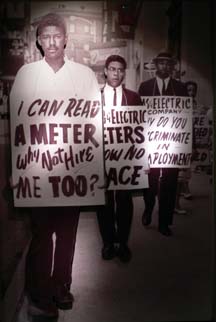
The Mount Moriah A.M.E. Church at 84 Franklin Street in historic Annapolis, a red-brick, neo-Gothic structure completed in 1687—soon after the abolition of slavery, barely made it to the National Register of Historic Places. In 1971 the church building was saved from demolition by a coalition of citizen groups and the Mt. Moriah congregation; in 1984 it became the Banneker-Douglass Museum. As the State’s Official Repository of African American history and culture, the museum is moving into a new era, with dynamic leadership and a renewed sense of its mission:
“. . . to collect, document, preserve, exhibit, and interpret objects and materials important to the African American history and culture of the State of Maryland.”
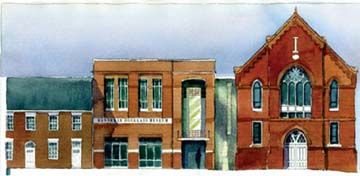
The museum is named for two Maryland-born, African-American leaders whose lives continue to inspire others: Benjamin Banneker (1731-1806) and Frederick Douglass (1818-1895).
Banneker was descended from slaves. Born a freeman in Ellicott’s Mills, he learned to read from his grandmother and a Quaker schoolmaster until he was old enough to help on the family farm. He then embarked on a lifelong journey of self-education, becoming an astronomer, clockmaker and publisher.
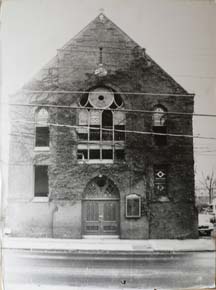 When he was 21, Banneker borrowed a neighbor’s pocket watch and made drawings of all of its pieces. After returning the watch, he carved large-scale wooden replicas of each piece, calculating the gear assemblies and using the parts to make a striking clock. The first watch made in America, his wooden pocket watch continued to work, striking each hour, for more than 40 years. When he was 21, Banneker borrowed a neighbor’s pocket watch and made drawings of all of its pieces. After returning the watch, he carved large-scale wooden replicas of each piece, calculating the gear assemblies and using the parts to make a striking clock. The first watch made in America, his wooden pocket watch continued to work, striking each hour, for more than 40 years.
In 1791, he was hired by Andrew and Joseph Ellicott to work with Pierre L’Enfant in surveying the Federal District to lay out the new capital of the United States. As an active campaigner against slavery, Banneker corresponded with Thomas Jefferson.
At the age of 58, he began the study of astronomy, calculating solar and lunar eclipses and compiling an ephemeris for the Benjamin Banneker Almanac that he published from 1792 to 1797. His astronomical calculations challenged the experts by accurately forecasting the 1789 solar eclipse.
 Twelve years after Banneker died, Douglass was born on the Maryland Eastern Shore, the son of a slave woman and an unknown white man. A 19th century abolitionist and escaped slave, he spent his early years with grandparents and an aunt; his mother died when he was seven. As a child, he was exposed to the degradations of slavery. At the age of 8, he was sent to Baltimore to live with a ship carpenter. There he learned to read and first heard the words ‘abolition’ and ‘abolitionist.’ Years later he wrote, “Going to Baltimore laid the foundation, and opened the gateway to all my subsequent prosperity.” Twelve years after Banneker died, Douglass was born on the Maryland Eastern Shore, the son of a slave woman and an unknown white man. A 19th century abolitionist and escaped slave, he spent his early years with grandparents and an aunt; his mother died when he was seven. As a child, he was exposed to the degradations of slavery. At the age of 8, he was sent to Baltimore to live with a ship carpenter. There he learned to read and first heard the words ‘abolition’ and ‘abolitionist.’ Years later he wrote, “Going to Baltimore laid the foundation, and opened the gateway to all my subsequent prosperity.”
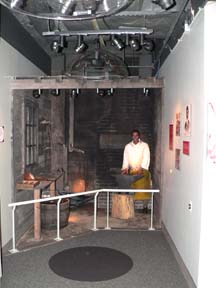 Unfortunately, after seven years in Baltimore, he was sent back to the country where Douglass was victimized by slavery. Hired out to a farm run by a notoriously brutal “slavebreaker,” he was whipped daily and barely fed. He described himself at this time as “broken in body, soul, and spirit.” Unfortunately, after seven years in Baltimore, he was sent back to the country where Douglass was victimized by slavery. Hired out to a farm run by a notoriously brutal “slavebreaker,” he was whipped daily and barely fed. He described himself at this time as “broken in body, soul, and spirit.”
Then in 1938, at the age of 21, Douglass ran away to New York before settling in New Bedford, MA. Always interested in furthering his education, he continued to read, joined a Black church and several abolitionist organizations. When he spoke about his life as a slave for the Massachusetts Anti-Slavery Society’s annual convention in Nantucket, the audience was so moved by his words, they invited him to lecture for the society. One abolitionist wrote of the event, “Flinty hearts were pierced, and cold ones melted by his eloquence.”
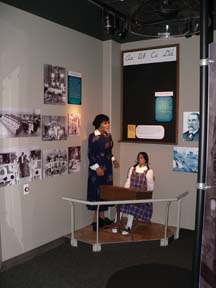 Douglass became a leading spokesperson for the abolition of slavery and for racial equality. In 1845, despite fear of losing his freedom, he published his autobiography, Narrative of the Life of Frederick Douglass, an American Slave. During the Civil War, he conferred with Abraham Lincoln and recruited northern Blacks for the Union Army. After the War, he lived in Washington, D.C., where he continued to fight for the rights of women and African-Americans alike. Douglass became a leading spokesperson for the abolition of slavery and for racial equality. In 1845, despite fear of losing his freedom, he published his autobiography, Narrative of the Life of Frederick Douglass, an American Slave. During the Civil War, he conferred with Abraham Lincoln and recruited northern Blacks for the Union Army. After the War, he lived in Washington, D.C., where he continued to fight for the rights of women and African-Americans alike.
Today, inspired by its namesakes and guided by Director Wendi Perry and a talented and enthusiastic staff, the Banneker-Douglass Museum is launching exciting plans for the years ahead. Perry is excited about their vast collection of every day life artifacts from African tribes from this area, including unique pieces, as well as their significant collection of African art.
Originally from St. Louis, MO, Perry has a varied background as a graphic artist, a Bachelor of Liberal Arts from SUNY and a Master’s in Public Administration from Southern Illinois University. She gained considerable experience as a textiles and costumes curator through her work on notable exhibits, such as the Louis and Clark collection and the Katherine Dunham costume collection.
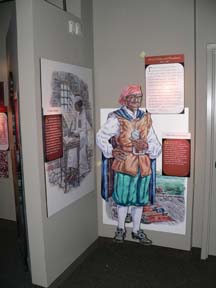 Perry is committed to the goals of expanding the exhibit space and increasing the staff. Since Governor Glendenning approved $6.1 million for expansion and renovation of the museum, they have improved the storage space for the collection, enhanced the research center, and increased the space available for performances and site rentals. One stunning feature of the renovation is the restoration and/or replacement of the original stained glass windows in the church building. The Museum hosted its first permanent exhibit, Deep Roots, Rising Waters this past January. Now Perry and the museum staff are excited about their grand opening to unveil the new lobby and special exhibits: February 27th, 9:00 a.m. to noon. Designed around the theme of a waterside dock, the lobby features a glass front from sidewalk to roof level, and a side wall of exposed red brick of the church. Exhibits feature selected artifacts from the archaeological investigations of the site: that triangle of land bounded by Franklin (formerly Doctor), Cathedral, and South Streets. Many artifacts are from the Summer of 2001 excavations, made possible by the Maryland Historical Trust of the Maryland Department of Housing and Community Development, the Maryland Humanities Council, the Maryland Commission on African American History and Culture, the Maryland Department of General Services, the Historic Annapolis Foundation and the University of Maryland College Park. Perry is committed to the goals of expanding the exhibit space and increasing the staff. Since Governor Glendenning approved $6.1 million for expansion and renovation of the museum, they have improved the storage space for the collection, enhanced the research center, and increased the space available for performances and site rentals. One stunning feature of the renovation is the restoration and/or replacement of the original stained glass windows in the church building. The Museum hosted its first permanent exhibit, Deep Roots, Rising Waters this past January. Now Perry and the museum staff are excited about their grand opening to unveil the new lobby and special exhibits: February 27th, 9:00 a.m. to noon. Designed around the theme of a waterside dock, the lobby features a glass front from sidewalk to roof level, and a side wall of exposed red brick of the church. Exhibits feature selected artifacts from the archaeological investigations of the site: that triangle of land bounded by Franklin (formerly Doctor), Cathedral, and South Streets. Many artifacts are from the Summer of 2001 excavations, made possible by the Maryland Historical Trust of the Maryland Department of Housing and Community Development, the Maryland Humanities Council, the Maryland Commission on African American History and Culture, the Maryland Department of General Services, the Historic Annapolis Foundation and the University of Maryland College Park.
 While archaeology has been critical to the history of Annapolis, African-American archaeology is key to understanding this vibrant community by providing information on people with few written records and who were marginalized, enslaved and free. Newly-designed exhibits, featuring on-site artifacts that document daily life, are the focus of their February opening. Exhibitions Specialist Amelia Harris is excited about the Child’s Play exhibit, a display of clay marbles, doll parts, a toy teacup, pitchers and saucer, framed with selected oral testimony of Delores Nichols, a frequent visitor to her grandparents and great-grandparents on Franklin Street in the 1930s and 1940s. Nichols recalls, “We used to play a lot of marbles. There was a vacant lot—that was our playground. We would draw a circle and shoot marbles, play touch football, baseball, whatever sport you wanted to play… I had my own marbles…I played ‘for fun,’ I wasn’t into it as much as the boys.” While archaeology has been critical to the history of Annapolis, African-American archaeology is key to understanding this vibrant community by providing information on people with few written records and who were marginalized, enslaved and free. Newly-designed exhibits, featuring on-site artifacts that document daily life, are the focus of their February opening. Exhibitions Specialist Amelia Harris is excited about the Child’s Play exhibit, a display of clay marbles, doll parts, a toy teacup, pitchers and saucer, framed with selected oral testimony of Delores Nichols, a frequent visitor to her grandparents and great-grandparents on Franklin Street in the 1930s and 1940s. Nichols recalls, “We used to play a lot of marbles. There was a vacant lot—that was our playground. We would draw a circle and shoot marbles, play touch football, baseball, whatever sport you wanted to play… I had my own marbles…I played ‘for fun,’ I wasn’t into it as much as the boys.”
 The exhibit Women’s Work Is Never Done displays buttons, several with military motifs, beads, a thimble, pins, and a metal clothes hook. These artifacts are reflected in images of a young woman sewing and an ad for a boarding house on Franklin Street, both illustrating how homemakers kept their families afloat by cooking and keeping house for paying boarders, taking in laundry and sewing for officers at the Naval Academy. Perry is excited about another unique exhibit featuring a section of earth embedded with significant archaeological deposits. Through its plexiglass front, visitors can observe the various depths of discovery of the artifacts excavated at the site. The exhibit Women’s Work Is Never Done displays buttons, several with military motifs, beads, a thimble, pins, and a metal clothes hook. These artifacts are reflected in images of a young woman sewing and an ad for a boarding house on Franklin Street, both illustrating how homemakers kept their families afloat by cooking and keeping house for paying boarders, taking in laundry and sewing for officers at the Naval Academy. Perry is excited about another unique exhibit featuring a section of earth embedded with significant archaeological deposits. Through its plexiglass front, visitors can observe the various depths of discovery of the artifacts excavated at the site.
The Banneker-Douglass Museum, one of the historical treasures of Annapolis, continues to grow. Former residents of 74-90 Franklin Street and their family members are invited to add oral history to their archives by contacting the museum at 410-216-6189. Other ways to be part of the work of the museum:
 Rent space for receptions or conferences Become a docent Rent space for receptions or conferences Become a docent
Volunteer to work in the library
Join the museum foundation
Make a donation
Purchase items in the museum gift shop
Museum visitors share the excitement from the space, the exhibits, and from the oral history provided by those such as Henry Holland, whose memories paint this picture of our friendly town:
“There were a lot of people on the street,… You spoke to everybody because everybody spoke… There was a closeness there.”
Back
|

